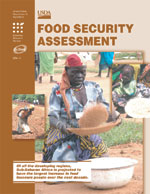Food Security Assessment, GFA 16
- by Shahla Shapouri, Stacey Rosen, Birgit Meade, Margriet Caswell and David Schimmelpfennig
- 4/28/2005
Overview
Just over 1 billion people in the 70 low-income countries studied in this report are estimated to have consumed less than the recommended nutritional requirements in 2004. This marks an increase from more than 830 million in 2003. Over the coming decade, food security is projected to improve most significantly in Asia, followed by Latin America and the Caribbean. The situation is expected to deteriorate in Sub-Saharan Africa, where deep poverty, political unrest, and the effects of HIV/AIDS hinder prospects for improvement.
Download
-
Food Security Assessment, GFA 16
Download PDF -
Abstract, Preface, and Acknowledgments
Download PDF -
Contents
Download PDF -
Summary
Download PDF -
Global Food Security: 2004 Assessment and Prospects
Download PDF -
Forces Shaping Food Security: Factors Affecting Production
Download PDF -
Forces Shaping Food Security: Factors Affecting Imports
Download PDF -
Genetically Engineered Corn in South Africa: Implications for Food Security in the Region
Download PDF -
Appendix 1: Food Security Model: Definition and Methodology
Download PDF -
Appendix tables 2a and 2b: List of countries and their food gaps in 2004
Download PDF -
Appendix 3: Country indicators
Download PDF -
North Africa?grain production, imports, and food gaps (4 countries)
Download XLS -
Sub-Saharan Africa?grain production, imports, and food gaps (37 countries)
Download XLS -
Asia?grain production, imports, and food gaps (10 countries)
Download XLS -
Latin America and the Caribbean?grain production, imports, and food gaps (11 countries)
Download XLS -
Commonwealth of Independent States?grain production, imports, and food gaps (8 countries)
Download XLS -
Commodity import shares of domestic supply: 1992-93 and 2001-02?cereal, vegetable oil, meat, sugar, and pulses
Download XLS
Releases
Check out the latest releases in this series.

